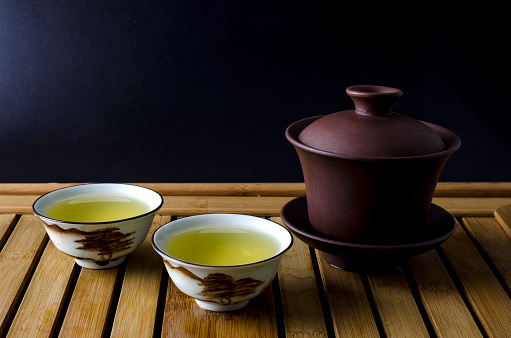
Comparative Cupping: Pouchong vs. Ali Shan
What is Comparative Cupping?
Comparative Cupping is the practice of steeping two teas for the purposes of identifying the unique characteristics of each juxtaposed against the other. This practice is useful for comparing different brands, harvests, and grades of tea. Comparative cupping also helps you develop your palate and allow you to better enjoy the subtle nuances characteristic to the tea plant. The best tool for identifying the flavor profiles of teas is the Aroma Wheel developed by the International Tea Masters Association.

Oolong teas lend themselves well to comparative cupping because oolongs are often shaped during processing which allows a myriad of flavors to unfold with each successive steeping as the leaves unfurl. In this case, we compared our Pouchong and Ali Shan teas over three 30-second infusions using a traditional Gaiwan.
Pouchong
Pouchong, also known as Baozhong tea, is a lightly oxidized oolong from Taiwan. Given the limited processing, this tea exhibits some of the same characteristics as both green teas and more heavily oxidized oolongs. Pouchong leaves are shaped by twisting.
First Infusion:
The first 30-second infusion of Pouchong produced a pale liquor (term used to describe the tea liquid) and exuded a mildly floral aroma. The floral notes were apparent in the flavor of the tea, but they were quite light.
Second Infusion:
With the second infusion, the liquor darkened to a light amber color and the flavor profile gained depth. This time around the floral notes were tempered by mineral undernotes and the tea finished with a lingering mouth feel. The leaves at this point gave off a distinctly buttery fragrance, with a hint of nuttiness.
Third Infusion:
With the third infusion the mineral and floral notes deepened for a much more robust cup than the first infusion. Mild vegetal notes also developed. The leaves mirrored this change and the buttery notes were layered with a scent reminiscent of edamame or green beans.
Ali Shan
Our Ali Shan is a high-altitude oolong grown in a mountainous region of Taiwan. Like Pouchong, this tea is considered a fairly green oolong and undergoes minimal oxidation. Ali Shan leaves are shaped by rolling.
First Infusion:
The first infusion of Ali Shan yielded a pale liquor with a light profile that hinted at flowers. The aroma exhibited notes of butter with a grassy finish.
Second Infusion:
The liquor of the second infusion boldened to a warm yellow color and the vegetal aroma increased. This infusion produced a cup with a much stronger vegetal flavor and was characterized by a bolder mouth feel.
Third Infusion:
With the third infusion of Ali Shan subtle honey notes appeared, rounding out the profile with a mild natural sweetness. The liquor turned a lovely amber hue and the cup exuded floral and honey scents.
Both Pouchong and Ali Shan are great options if you prefer flavor profiles reminiscent of green teas without the astringency. Furthermore, both of these teas offer characteristics of darker oolongs without the same levels of caffeine. Really, these oolongs are the best of both worlds. You can purchase our Ali Shan tea here. If you're interested in Pouchong, check out our Tropical Coconut blend which combines Pouchong leaves with delicious coconut and pineapple. Happy Steeping!
What is Comparative Cupping?
Comparative Cupping is the practice of steeping two teas for the purposes of identifying the unique characteristics of each juxtaposed against the other. This practice is useful for comparing different brands, harvests, and grades of tea. Comparative cupping also helps you develop your palate and allow you to better enjoy the subtle nuances characteristic to the tea plant. The best tool for identifying the flavor profiles of teas is the Aroma Wheel developed by the International Tea Masters Association.

Oolong teas lend themselves well to comparative cupping because oolongs are often shaped during processing which allows a myriad of flavors to unfold with each successive steeping as the leaves unfurl. In this case, we compared our Pouchong and Ali Shan teas over three 30-second infusions using a traditional Gaiwan.
Pouchong
Pouchong, also known as Baozhong tea, is a lightly oxidized oolong from Taiwan. Given the limited processing, this tea exhibits some of the same characteristics as both green teas and more heavily oxidized oolongs. Pouchong leaves are shaped by twisting.
First Infusion:
The first 30-second infusion of Pouchong produced a pale liquor (term used to describe the tea liquid) and exuded a mildly floral aroma. The floral notes were apparent in the flavor of the tea, but they were quite light.
Second Infusion:
With the second infusion, the liquor darkened to a light amber color and the flavor profile gained depth. This time around the floral notes were tempered by mineral undernotes and the tea finished with a lingering mouth feel. The leaves at this point gave off a distinctly buttery fragrance, with a hint of nuttiness.
Third Infusion:
With the third infusion the mineral and floral notes deepened for a much more robust cup than the first infusion. Mild vegetal notes also developed. The leaves mirrored this change and the buttery notes were layered with a scent reminiscent of edamame or green beans.
Ali Shan
Our Ali Shan is a high-altitude oolong grown in a mountainous region of Taiwan. Like Pouchong, this tea is considered a fairly green oolong and undergoes minimal oxidation. Ali Shan leaves are shaped by rolling.
First Infusion:
The first infusion of Ali Shan yielded a pale liquor with a light profile that hinted at flowers. The aroma exhibited notes of butter with a grassy finish.
Second Infusion:
The liquor of the second infusion boldened to a warm yellow color and the vegetal aroma increased. This infusion produced a cup with a much stronger vegetal flavor and was characterized by a bolder mouth feel.
Third Infusion:
With the third infusion of Ali Shan subtle honey notes appeared, rounding out the profile with a mild natural sweetness. The liquor turned a lovely amber hue and the cup exuded floral and honey scents.
Both Pouchong and Ali Shan are great options if you prefer flavor profiles reminiscent of green teas without the astringency. Furthermore, both of these teas offer characteristics of darker oolongs without the same levels of caffeine. Really, these oolongs are the best of both worlds. You can purchase our Ali Shan tea here. If you're interested in Pouchong, check out our Tropical Coconut blend which combines Pouchong leaves with delicious coconut and pineapple. Happy Steeping!


